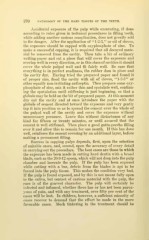Page 422 - My FlipBook
P. 422
270 PATHOLOGY OF THE HARD TISSUES OF THE TEETH.
Accidental exposure of the pulp while excavating, if done
according to rules given in technical procedures in filling teeth,
while adding another serious complication, does not greatly add
to the danger. After the application of ' ' 1-2-3, ' ' or oil of cloves,
the exposure should be capped with oxyphosphate of zinc. To
make a successful capping, it is required that all decayed mate-
rial be removed from the cavity. Then take a bit of ordinary
writing-paper and cut a piece that will cover the exposure and
overlap well in every direction, or in this class of cavities it should
cover the whole pulpal wall and fit fairly well. Be sure that
everything is in perfect readiness, the rubber dam in place and
the cavity dry. Having tried the prepared paper and found it
of proper size, flood the cavity with oil of cloves, "1-2-3" or
other equally non-irritating antiseptic. Then prepare some oxy-
phosphate of zinc, mix it rather thin and spatulate well, continu-
ing the spatulation until stiffening is just beginning, so that a
globule may be held on the bit of prepared paper. At this moment
dry out the cavity and at once introduce the paper with the
globule of cement directed toward the exposure and very gently
tap it into position so as to spread the cement over the whole of
the pulpal wall of the cavity and cover the exposure without
unnecessary pressure. Leave this without disturbance of any
kind for fifteen or twenty minutes, or until assured that the
cement is well stiffened. Then place a good gutta-percha filling
over it and allow this to remain for one month. If this has done
well, reinforce the cement covering by an additional layer, before
making a permanent filling.
Success in capping pulps depends, first, upon the selection
of suitable cases, and, second, upon the accuracy of every detail
in carrying out the procedure. The best cases are those in which
the exposure has been made in cutting hard dentin with a broad
blade, such as the 20-9-12 spoon, which will not drop into the pulp
chamber and lacerate the pulp. If the pulp has been exposed
while cutting with a bur, debris from the blades is apt to be
forced into the pulp tissue. This makes the condition very bad.
If the pulp is found exposed, and by this is not meant fully open
to the saliva, but contact of carious material with the pulp, the
case is of the gravest character. The pulp will certainly be
infected and inflamed, whether there has or has not been parox-
ysms of pain, and with any treatment, over fifty per cent of the
cases will be lost. In children, however, a sufficient minority of
cases recover to demand that the effort be made in the more
favorable cases. Much tinkering in the treatment should be


